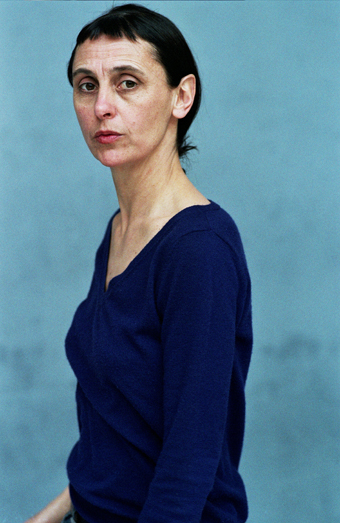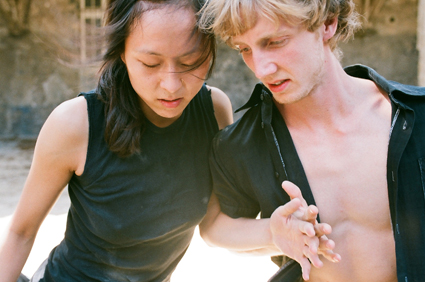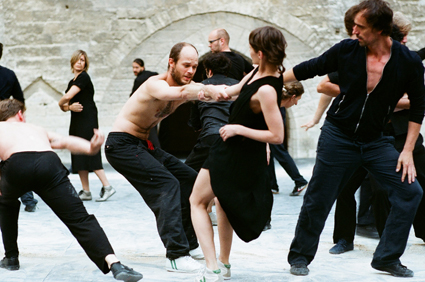anne teresa de keersmaeker speaks
keith gallasch: artist talk, en atendant, cesena, carriageworks

Anne Teresa De Keersmaeker
photo Herman Sorgeloos
Anne Teresa De Keersmaeker
AFTER THE FIRST PERFORMANCE OF CESENA BY BELGIUM’S ROSAS AND GRAINDELAVOIX AT CARRIAGEWORKS, ANNE TERESA DE KEERSMAEKER, CO-CREATOR OF THE WORK (WITH MUSIC DIRECTOR BJORN SCHMELZER) SPOKE ELOQUENTLY ABOUT HER WORK WITH DANCE WRITER AND ACADEMIC ERIN BRANNIGAN AND ANSWERED QUESTIONS FROM THE AUDIENCE. THE FOLLOWING REPORT IS TAKEN FROM HURRIED HANDWRITTEN NOTES.
Not one to be rushed, De Keersmaeker’s thoughtful pauses and moments of animation complemented En Atendant and Cesena, the intensely contemplative and grandly passionate works we’d had the great privilege to witness in a mere week in the only venue in Sydney that could accommodate such creations. En Atendant evokes the transition from twilight to night, while Cesena emerges from near darkness to sunrise.
De Keersmaeker first responded to Brannigan’s question about the origins of the work, including its 2011 Avignon Festival premiere, at considerable length (in fact answering all the other questions Brannigan had in store).
Emphasising, as she did repeatedly, that music is integral to her practice, De Keersmaeker spoke of her attraction to Ars Subtilior, a late 14th century compositional form associated with Avignon. She described the music as “highly complex, contrapuntal, mathematical,” “with different time layers” but also “the highest emotional intensity.”
For the choreographer, Ars Subtilior evokes the end of the Dark Ages and the transition into the light of the Renaissance. At the same time it captures the agonies of the late Mediaeval Period—plague spread by fleas in clothing and on rats, the depredations of the One Hundred Years War and a deteriorating and corrupt Roman Catholic Church, epitomised by the split in the Holy Roman Empire between competing papacies in Avignon and Rome. De Keersmaeker sees Ars Subtilior as “music emerging out of chaos,” light out of the dark.
When asked to create a new work for the festival in Avignon, the choreographer hesitated. Acknowledging the festival’s greatness she nonetheless described it as a circus. She was told, “You’ll never have silence” for a contemplative work. Later in the talk she would explain how she addressed this challenge.

En Atendant, Rosas, Cloître des Célestins, Avignon, France
photo © Herman Sorgeloos
En Atendant, Rosas, Cloître des Célestins, Avignon, France
The key impulse for the creation of the En Atendant and Cesena diptych—which is how De Keersmaeker labelled these works performed on separate nights—was revealed to be the choreographer’s preoccupation with “the very nature of how movement is generated in the body.” She described breathing as “the most ecological, intimate movement,” manifest as well in sounds, speech, screaming and lamentation. Secondly she addressed the verticality of the spine: “our walking is our dancing. With walking we organise space and time,” she said, tapping her feet. “Walking is the basic architecture of movement.”
The mention of architecture appeared to trigger a reflection on her relationship with visual artist Anne Veronica Janssens, whom she described as mostly working with light, severely and elegantly, with a kind of minimalism, which the choreographer emphasised should not be associated with American minimalism or Arte Povera. De Keersmaeker had worked with Janssens previously using the music of Bach and Webern, and danced, and, surprisingly, told us she sang in a performance of Mahler’s Song of the Earth.
De Keersmaeker had long been struck by the transformation that occurs when a work rehearsed at great length in daylight is taken into a dark theatre with artificial light at night: “it changes the architecture, the dynamic of what is happening.” She decided she wanted “to work with natural daylight; to make a piece for sunrise.” Consequently, Cesena was premiered at 4.30am at the Avignon Festival, outdoors at the Palace of the Popes.
What informs her work, said the choreographer, “is a passion for abstract beauty—maths, geometry. But I’m very emotional and intuitive.” Smiling, she added, “Although I have a reputation for being very severe, I can be gentle.”
She addressed this in terms of her strong association with music: “Music frames my basic nature…[it provides] order in the highest degree of chaos.” However, “I skipped the 19th century…except for Mahler and early Schonberg—romantic music on the edge of change.”
Brannigan asked De Keersmaeker where the new diptych stood in the choreographer’s body of work. After a long silence, she answered hesitantly that her early work, in which she danced and taught herself how to choreograph, had an “economy of means, extreme repetition” and was minimalist. In her latest work she sensed “a new minimalism.”
Brannigan enquired if ‘community’ was significant in De Keersmaeker’s work to which the choreographer answered that it was: “it’s beautiful and political…a community of people and [each] person in all their complexity.” She declared, “dance makes me love people. These works were made with these people.”
Responding to audience questions about the music in the diptych, she said that Bjorn Schmelzer had chosen the pieces but without any thematic rigidity. Opposing the “holy boxing and sterilising” of music from the past, she said “our bodies are more contemporary than anything else. We visit this old music with our bodies and the grain of the voice gives it a completeness.”

Carlos Garbin (left centre) and Marie Goudot (right centre), Cesena, Rosas at Palais des Papes in Avignon, France
photo © Anne Van Aerschot
Carlos Garbin (left centre) and Marie Goudot (right centre), Cesena, Rosas at Palais des Papes in Avignon, France
One of the most powerful elements of Cesena is that the companies of dancers and singers merge into one, sometimes significantly blurring their roles and amplifying the sense of community. A few dancers, said De Keersmaeker, could not sing, unless, as in the case of a Serbian dancer, it connected with their cultural background. Matej Kejzar performed a fragment of a Serbian epic poem dealing with loss, an angrily delivered lament, sung with raw passion. On the other side of the stage the rest of the company gathered in a circle, accompanying him contrapuntally with melancholy serenity. For De Keersmaker, the song recalls the grieving over the three-day massacre of the citizens of Cesena in northern Italy ordered by the Pope during the schism within the empire, and more recently the Serbian-Bosnian war.
De Keersmaeker made the point that Schmelzer did not aim for polished performances, nor did she. “My approach to movement is architectural.” She saw herself as realising a “materialised energy…a natural and complex richness” rooted in informal movement. As Alex Ferguson reported from the Festival TransAmériques 2012, Montreal:
“The greatest vocal challenges are left to the singers, and the most difficult movement solos are left to the dancers; but for the most part the bodies all sing and move—to very high standard. Walking, turning, rolling and singing with collective intent, the performers form a community of initiates with a holy mission: to awaken the sun—or its proxy, electric light. They succeed.” (RT110):
For Cesena, designer Janssens created a large white circle—a thin but dense chalk-like line that is gradually scuffed and spread, either gently or forcefully for the duration of the performance. The performers move inside and out of it, across it (running or intersecting it with long lines or in halting group marches). Asked how the performers, sometimes each in their own circular trajectory within a larger mass, could move with ease, De Keersmaeker described the circle as containing “circles within circles,” with each performer having visualised their own pattern, “knowing the time when they should switch or rotate,” “following a performer on the edge of the circle,” hearing that person’s name called, “using their peripheral vision…and knowing what can go wrong.” (I spoke to a dancer after seeing En Atendant. He told me that the concentration required in that work, with its own acute patterning, was more demanding than the physical expenditure.)
In En Atendant there is a thin, straight line of what looks like soil (designer Michel Francois, also a Belgian artist), just in front of the audience. Like the circle in Cesena it’s a line also frequently breached and blurred. To the right, a trio of musicians sit on a bench—a singer and two instrumentalists. The dramaturgy is quite formal compared with Cesena, “the movement rooted in the music.” In Cesena, De Keersmaeker wanted “only the body,” operating inside and out of “that most complete of forms, the circle.” The result: dancers who sing and singers who dance, one community, celebrating light, the body—at once “most ancient and contemporary”—and, “most individual of all, the voice.” For De Keersmaker, the sharing of music and movement is central to Cesena, such that she and her performers created “simple movements while doing complex singing.”
Another motivation for the creation of Cesena’s sole focus on the body, said De Keersmaeker, was a response to “the technicalised world post-WWII,” not least the dominance by speed that came with it and the technologies that negate the body.
To hear De Keersmaeker speak after seeing En Atendant and Cesena was deeply satisfying. The breadth and depth of her vision, the scale and intensity of her collaborative creations and their gravitas are inspiring. With Rosas, she last visited Australia in 2000 for Robyn Archer’s Adelaide Festival of that year, presenting the monumental I Said I, two and a half hours of superb dancing, brilliantly integrated text delivered by the dancers and music provided by a piano trio and a DJ and saxophonist. Not since the trio of Pina Bausch Tanztheater Wuppertal works in the 1982 Jim Sharman Adelaide Festival had a work so swept us up with its delicious intricacies, momentum, passion and intelligence. And now in 2012, new works by De Keersmaeker are embedded deep in our bodies and psyches. She leaves us feeling we have danced the dance, and sung it, with Rosas and graindelavoix.
–
Carriageworks & the 18th Biennale of Sydney: Rosas, En Atendant, Sept 11, 12; Rosas and graindelvoix, Cesena, Sept 14. 15; Carriageworks, Sydney; artist talk, Sept 14
Footage of Cesena in Avignon can be viewed on vimeo
This article originally appeared in RT’s online e-dition Sept 18
RealTime issue #111 Oct-Nov 2012 pg. web






